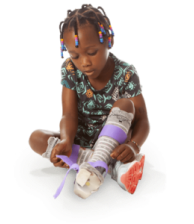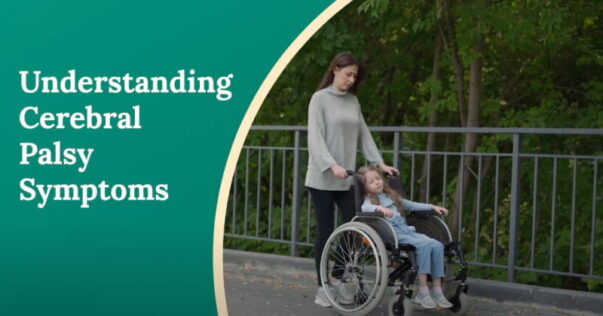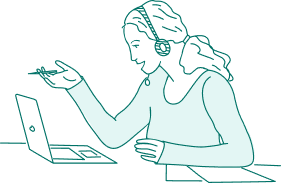What are the symptoms of cerebral palsy?
Cerebral palsy (CP) symptoms usually involve movement, muscle control, and coordination due to brain damage before, during, or shortly after birth.
Symptoms vary based on the type and severity of the brain injury, but they often include difficulties with posture, balance, and fine motor skills.
Many cases of cerebral palsy are not diagnosed until toddlerhood, as early symptoms can be tough to spot. As children grow, delays in walking, speech difficulties, and involuntary movements may become more noticeable.
Signs of cerebral palsy in babies often involve unusual muscle tone — either too stiff or too floppy — or struggles with movements like rolling over, sitting up, or grasping objects.
Parents and caregivers are often the first to notice early signs of cerebral palsy in newborn babies, making their observations critical in seeking early diagnosis and appropriate care.
If you suspect your child could have cerebral palsy, trust your instincts. Sometimes, doctors dismiss concerns during birth, but ongoing developmental delays could signal a birth injury.
Your family may be eligible for financial compensation if a preventable birth injury led to your child’s condition. A cerebral palsy lawsuit could help cover medical costs, therapy, and long-term care.
Cerebral Palsy Guide works with a network of top birth injury lawyers across the country. Our legal partners have recovered over $1 billion for families affected by preventable birth injuries. We may be able to help your family, too.
Get a free case review right now to see if you could be eligible for financial compensation.
Early signs and symptoms of cerebral palsy
The early signs of cerebral palsy can be hard to detect, especially since every baby develops at their own pace. However, certain symptoms may point to possible problems.
This may be especially true if your baby experienced a birth complication like hypoxic ischemic encephalopathy (HIE), a risk factor for CP.
HIE is a serious type of brain injury caused by a lack of oxygen during birth. It is also one of the leading causes of cerebral palsy.
If your baby had HIE, they may be at higher risk of developing CP, so watching for early signs is especially important.
Symptoms often appear in how babies move, respond, and develop compared to other children their age. Some babies may feel stiff or rigid, while others seem overly floppy or have trouble controlling their movements.
Parents might notice developmental delays in rolling over, sitting up, or holding their heads steady. Recognizing these early signs helps families get prompt medical support and start beneficial treatments sooner.
Watch our short video to learn more about the symptoms of cerebral palsy.
Learn the common symptoms of cerebral palsy. If your child is impacted, you may be able to access the money your family needs for care. View Transcript.
Duration: 1 min 35 sec
Cerebral palsy is a condition that affects how your body moves. Let's explore some of the common symptoms that can occur.
One symptom of cerebral palsy is trouble with fine motor skills. This means that tasks like writing, drawing, or using buttons and zippers can be more challenging.
Mobility can be affected by cerebral palsy, making it harder to walk or move around. Some children with CP may need assistive devices like crutches or a wheelchair to help them get around.
Cerebral palsy can affect coordination, making it harder to control movements. This might result in stumbling, trouble with balance, or difficulty performing activities that require precise coordination.
Another symptom of cerebral palsy can be difficulties with speech. Some children with CP may have trouble speaking clearly or pronouncing certain sounds, which can affect their ability to communicate.
According to the Centers for Disease Control and Prevention (CDC), 41% of children with cerebral palsy had limited ability to crawl, walk, run, or play.
It's important to note that in some cases, cerebral palsy may be caused by medical malpractice. If you suspect negligence or improper medical care, we may be able to help.
Connect with us today to speak with one of our labor and delivery nurses. They can help figure out if you’re entitled to the financial compensation you need to manage your child’s cerebral palsy symptoms.
Cerebral palsy symptoms by age
Cerebral palsy symptoms can look different as a child grows. Some issues become clearer with age, especially as children miss developmental milestones.
Because cerebral palsy is caused by brain damage, symptoms may change with brain development. Learn more about the signs and symptoms of cerebral palsy at different stages below.
Cerebral palsy symptoms in babies


- Delayed milestones like sitting, rolling, or crawling
- Difficulty holding their head up or turning it
- Excessive drooling or trouble feeding
- Legs crossing (scissoring) or becoming stiff when lifted
- Overly tight or stiff muscles
- Trouble grasping toys or reaching out
- Unusual posture, such as arching the back
Doctors typically diagnose cerebral palsy by closely observing your baby's development, performing physical exams, and ordering tests like brain scans. If your baby shows one or more of these signs, it's important to talk to your pediatrician right away.
Cerebral palsy symptoms in toddlers
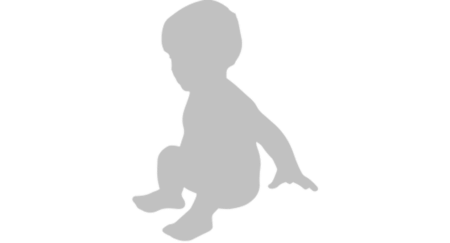

- Balance problems, like frequent falls or being unsteady
- Crawling unevenly or scooting instead of walking
- Crossing of legs when walking or scissoring gait
- Mobility limitations, like dragging one leg or tiptoeing
- Muscle movements that seem stiff (spasticity) or jerky
- Problems holding small items like crayons, forks, or toothbrushes
- Sensory issues, including hearing or vision problems
- Speech delays or difficulty speaking clearly
Additionally, joint and bone deformities, such as contractures and hip dislocations, are common in children with cerebral palsy due to muscle imbalances.
If your child shows any of these signs, talk to a doctor. Getting proper cerebral palsy treatment early can make things easier for your child as they grow.
For example, surgery like selective dorsal rhizotomy, where the nerves causing stiff muscles in the legs are cut. Orthopedic specialists help manage severe cerebral palsy symptoms, including contractures (when tight muscles pull on the joints, making them harden and become extremely rigid with limited mobility).
Cerebral palsy and medical malpractice
Some children develop cerebral palsy because of mistakes made by medical professionals during birth. When doctors, nurses, or other health care providers don't provide the expected standard of care, babies can suffer serious injuries.
These injuries can cause permanent brain damage, leading to lifelong challenges. In these cases, it may be considered medical malpractice.
- Delaying or not performing a necessary cesarean section (C-section)
- Failing to identify or treat infections during pregnancy or birth
- Ignoring signs of fetal distress, such as changes in heart rate
- Mismanaging complications like umbilical cord issues, which can limit oxygen
- Misusing delivery tools like forceps and vacuum extractors
Medical providers are responsible for making quick, safe decisions during childbirth.
Unfortunately, when something goes wrong, they might deny their role or minimize the injury they caused.
If you think your child's cerebral palsy symptoms were caused by a preventable medical mistake, legal professionals can help. We may be able to connect you with a skilled cerebral palsy lawyer near you who can explain your options.
Get started with a free case review right now.
Cerebral palsy symptoms by type
When the motor control centers of the developing brain are damaged, it can result in several types of movement issues. These limitations and their corresponding symptoms vary based on the severity and location of the brain injury, as well as the child’s specific type of cerebral palsy.
Learn more about the symptoms of cerebral palsy by each type below.
Spastic cerebral palsy symptoms
Symptoms of spastic cerebral palsy include jerky movements and tight muscles caused by damage to the motor cortex and/or pyramidal tracts. Spastic cerebral palsy is the most common form of CP, making up about 80% of diagnoses.
Common symptoms of spastic cerebral palsy include:
- Abnormal walking
- Awkward reflexes
- Muscle stiffness of one side of the body
- Permanently tightened muscles or joints
This type of cerebral palsy often causes movement disorders, including quadriplegia (all 4 limbs), diplegia (2 limbs), and spastic hemiplegia.
Ataxic cerebral palsy symptoms
Symptoms of ataxic cerebral palsy include poor balance and coordination caused by damage to the brain’s cerebellum.
Common symptoms of ataxic cerebral palsy include:
- Coordination issues
- Depth perception problems
- Difficulty with speech
- Shakiness and tremors
- Spreading feet apart when walking
Ataxic CP is associated with unsteady movements, tremors, and a wide-based gait.
Athetoid or dyskinetic cerebral palsy symptoms
Dyskinetic or athetoid cerebral palsy causes involuntary, uncontrolled movements due to damage in the basal ganglia or cerebellum, areas of the brain responsible for coordination and muscle control.
Common symptoms of athetoid cerebral palsy include:
- Feeding issues
- Floppy limbs
- Problems with posture
- Stiff or rigid body
Uncontrollable movements can shift daily, ranging from weak and floppy to overly tense, depending on muscle tone.
The movements can be primarily slow and writhing or rapid and jerky, making it challenging to perform everyday activities without assistance.
Hypotonic cerebral palsy symptoms
Hypotonic cerebral palsy is caused by damage to the cerebellum, the part of the brain that controls muscle tone, balance, and coordination.
Children with this type of cerebral palsy have lower-than-normal muscle tone, making their bodies feel floppy or limp.
Common symptoms of hypotonic cerebral palsy include:
- Extremely flexible joints and ligaments
- Floppy or loose muscles
- Lack of head control
- Poor balance and stability
Because hypotonia affects strength and stability, children may take longer to reach milestones like crawling, walking, or standing without support.
Mixed cerebral palsy symptoms
This type of CP occurs when damage affects multiple areas of the brain involved in motor control. Mixed cerebral palsy combines symptoms from two or more forms of CP, resulting in a wide range of physical challenges.
The most common forms of mixed cerebral palsy are spastic-dyskinetic (athetoid) and spastic-ataxic. Because mixed cerebral palsy involves multiple symptom types, treatment typically requires a customized approach to address each child's unique needs.
Co-occurring conditions with cerebral palsy symptoms
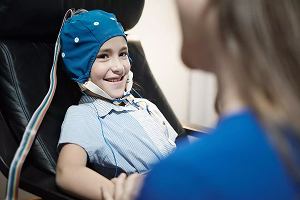

Cerebral palsy primarily affects movement and motor skills but can involve other neurological conditions. Kids with CP are also more likely to have coexisting conditions.
For example, hip dislocation is a common issue in children with cerebral palsy due to abnormal muscle tone and uneven pressure on joints.
Children with cerebral palsy often experience neurological conditions, including:
- Attention deficit hyperactivity disorder (ADHD)
- Behavioral challenges
- Epilepsy (seizure disorders)
- Intellectual disabilities
- Learning disabilities
- Sensory processing issues
- Spectrum disorders, like autism
- Speech and language difficulties (dysarthria)
- Vision or hearing impairments
Data from the Autism and Developmental Disabilities Monitoring (ADDM) Network shows that about 42% of children with cerebral palsy also have epilepsy.
Diagnosing neurological conditions in young children can be challenging, especially if they struggle with speech or hand movements.
Closely monitoring your child’s development and behaviors can help identify symptoms of cerebral palsy early.
Secondary symptoms of cerebral palsy
The inability to control motor function can lead to many secondary cerebral palsy symptoms. Children may struggle to independently complete basic activities like eating.
Children with severe cases of cerebral palsy are more likely to experience secondary symptoms than children with mild cases of the condition.
- Constipation
- Contractures
- Difficulty breathing
- Frequent bone fractures
- Gastroesophageal reflux
- Hernias (organ pushing through a weak muscle wall)
- Incontinence (inability to control bladder or bowel)
- Scoliosis, a curvature of the spine
- Sleep disorders
- Stunted growth
- Tooth and gum disease
These conditions may make it difficult for your child to complete daily tasks, get proper nutrition, and live an independent and pain-free life. Consulting with a cerebral palsy specialist is the best way to get your child proper treatment to provide them with a better quality of life.
Get legal help for cerebral palsy
Children with cerebral palsy can experience a range of physical and neurological symptoms, depending on the type and location of their brain injury.
Monitoring your child’s development is important. If they are missing key milestones, talk to a doctor. With the right care, many children with cerebral palsy can manage their symptoms and lead healthy, independent lives.
For many parents, learning that their child has cerebral palsy raises difficult questions about what caused their condition and what comes next. If medical negligence played a role, legal action may help secure the financial support needed for treatment, therapy, and lifelong care.
An experienced cerebral palsy lawyer can investigate whether your child’s condition was preventable and help you navigate the legal process.
Our legal partners have secured over $1 billion for families like yours. We may be able to help your family, too.
Call us right now at (855) 220-1101 or get a free case review to find out if you could be eligible for financial compensation.

